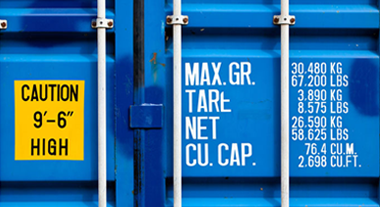Patricks Infrastructure Surcharge

New technology at Victoria International Container Terminal (VICT) has revealed a staggering number of boxes with mis-declared weight declarations. Data diclosed from VICT at a recent Container Transport Alliance Australia forum in Yarraville showed:
For import containers:
• 40% of containers were mis-declared by plus or minus 500 kilos
• About 8-11% were mis-declared by plus or minus one tonne
• Between 3% and 7% were mis-declared by plus or minus two tonnes
For export containers:
• About 20% of the containers were mis-declared by plus or minus 500 kilos
• About 7% for plus or minus a tonne
• About 3% for plus or minus two tonnes
The shipper is responsible for providing a verified gross mass for every container. The accuracy of the container weights declared is an important safety measure and allows the master of the vessel to plan ship loading, so that the ship is stable, hull strength and stack weights are not exceeded and securing arrangements are effective. Incorrectly declared weights can be detrimental, resulting in container collapse, personal injury and damage to equipment.
These are concerning figures for Australian Maritime Safety Authority (AMSA) and discussions with the stevedore have taken place. A spokesperson for AMSA has advised that “if a terminal suspects a shipper has not obtained a VGM in compliance with Marine Order 42, the details should be referred to AMSA.”
AMSA have the authority to audit shippers’ processes for obtaining the verified gross mass of containers. However, they usually take an educational approach to ensure shippers understand their obligations. In saying this, they also have the power to impose penalties where necessary to ensure compliance.
For import containers:
• 40% of containers were mis-declared by plus or minus 500 kilos
• About 8-11% were mis-declared by plus or minus one tonne
• Between 3% and 7% were mis-declared by plus or minus two tonnes
For export containers:
• About 20% of the containers were mis-declared by plus or minus 500 kilos
• About 7% for plus or minus a tonne
• About 3% for plus or minus two tonnes
The shipper is responsible for providing a verified gross mass for every container. The accuracy of the container weights declared is an important safety measure and allows the master of the vessel to plan ship loading, so that the ship is stable, hull strength and stack weights are not exceeded and securing arrangements are effective. Incorrectly declared weights can be detrimental, resulting in container collapse, personal injury and damage to equipment.
These are concerning figures for Australian Maritime Safety Authority (AMSA) and discussions with the stevedore have taken place. A spokesperson for AMSA has advised that “if a terminal suspects a shipper has not obtained a VGM in compliance with Marine Order 42, the details should be referred to AMSA.”
AMSA have the authority to audit shippers’ processes for obtaining the verified gross mass of containers. However, they usually take an educational approach to ensure shippers understand their obligations. In saying this, they also have the power to impose penalties where necessary to ensure compliance.









